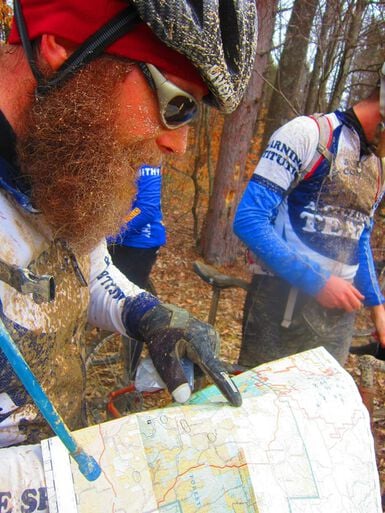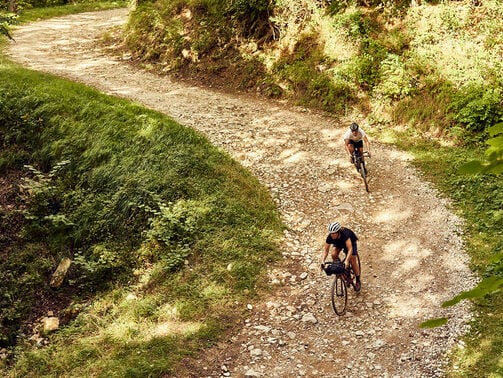Cyclocross vs gravel bike: Key differences and which is better for you
Both gravel and cyclocross bikes are capable off-road machines. But what exactly are the differences between the two?


At first glance, a cyclocross and a gravel bike look pretty similar. After all, they both feature drop bars and knobby tyres and are meant to be ridden over rough terrain. But there are pretty significant differences between the two types of bikes as well. Let’s explore them.
Contents
Cyclocross vs gravel bike geometry: How riding position differs
A cyclocross (CX) bike boasts a higher bottom bracket than a typical gravel bike, allowing the rider to tackle the larger obstacles they’ll find on a CX course. It typically has a longer reach, putting the rider in a more aerodynamic position for greater speed. A shorter wheelbase makes the CX bike nimbler, allowing the rider to instantly respond to the twists, turns, and surprises they’ll find on a typical cyclocross race.
Most CX bikes have a large main triangle, making it easier to shoulder the bike. Canyon goes a step further with their Inflite design, offering the so-called “comfort kink,” a wide bend where the top tube meets the seat tube, offering an easy and more comfortable way to slide the bike onto the rider’s shoulder.

Gravel bikes have a longer wheelbase than the average CX rig, giving them more stability over the loose and rough rocks. The riding position is more upright, making the bikes more comfortable over multiple hours and longer distances
When accounting for the bar and stem, an Inflite CF SL 6 in size medium has a Reach+ measurement of 462 mm and Stack+ measurement of 663 mm, compared to a medium Grail CF SL 7’s 459 and 669 and Grizl CF SL 8’s 461 mm and 666 mm. Both the Grizl and Grail offer longer wheelbases (offering more stablity), at 1,037 and 1,057, respectively, than the Inflite’s 1,018.
Curious to learn more about gravel bike geometry? Check out our in-depth guide. Wondering how road bike geometry affects performance? We've got a guide for that too.

Tyres and tyre clearance distinctions
Wide tyres aid a gravel bike’s stability. An adventure-focused gravel bike like the Grizl is meant to venture into a wide variety of terrain. So, the Grizl comes equipped with 45 mm Schwalbe G-One Bite tyres, but can take up to 50 mm rubber. The more race-oriented Grail comes equipped with Schwalbe G-One R 40mm tyres with the ability to go 2 mm wider. Tyre clearance is just one of several differences between the Grizl and Grail - explore more to see which gravel bike suits your riding style.
A cyclocross bike needs somewhat more narrow tyres, allowing the rider to carve into corners. The Inflite CF SL 6 comes with 33 mm Schwalbe X-One R Evo standard rubber, with the ability to go up to 38 mm tyres for muddy conditions. Curious about how to decide on tyre pressure before a ride, check out our guide.
Cyclocross vs gravel bike gearing and drivetrain
Cyclocross bikes typically have a more narrow gear range than gravel bikes. Most amateur racers employ either a 1X or 2X drivetrain with a cassette ranging from 10-36 to 11-34. This gear range is typically wide enough to handle fast, flat portions of the course as well as the short, steep hills (that you may have to run up anyway).
For gravel riders, particularly the adventure-seekers, the world is the course, so their bikes need a much wider range of gears, given the variety of terrain one can expect to find while riding. They need a drivetrain that can conquer long, grinding hills as well as flat roads that stretch out forever. On a 2X setup, expect to find something along the lines of a 50/34 in front and 11-34 or 11-36 cassette in the rear. If you choose a Grizl with a 1X setup, it may boast a massive 11-44 cassette on the back.
Road bike groupsets are designed for speed, precision, and efficiency – ideal for smooth tarmac and fast-paced riding. If you’re unsure which system suits your needs, check out our road bike groupset guide. Gravel bike groupsets, on the other hand, are built for durability and control across varied terrain. Our dedicated gravel bike groupset overview breaks down the differences and covers everything you need to know about gravel-specific setups.
Handling and performance on different terrain
As discussed in the geometry section, both cyclocross and gravel bikes are going to perform very differently. Cyclocross bikes are all-out race machines, designed to be fast and nimble on tight, windy courses and able to roll over obstacles at speed.
A gravel bike like the Grail is fast and stable over longer distances and rocky terrain, while the Grizl is a tank that can tackle nearly anything you can throw at it. Both gravel bikes offer a more comfortable, upright position for the hours you’ll spend riding versus a cyclocross bike’s more tucked-in position that you need to maintain for 45 minutes to an hour, typically.
Mounts, luggage, and accessories: What can each bike carry?
Traditional gravel bikes will have multiple bolts where you can attach packs and other accessories. Grizl models have the most gear mounting positions of Canyon’s bike offerings, while Grail models don’t come with mounting bolts on the front fork. Canyon’s website offers multiple accessories for you to turn your rigs into capable bikepacking machines.
Canyon’s Inflite models have bolts for you to attach water bottle cages, but not much else. You can find secondary-market accessories that use Velcro or other types of straps if you’d like to use your cyclocross bike to go bikecamping.
Can you use a cyclocross bike for gravel riding (and vice versa)?
I rode my cyclocross bike on gravel roads and dirt trails for years. Over long distances, it’s not as comfortable as a traditional gravel bike, but it can be done. If you own a Grail or Grizl and want to hop into a local cyclocross race once a year, you should be OK. (Although if you own a Grizl, you may want to schedule an appointment with your chiropractor now depending on how many times you need to shoulder your bike and run.)
Final thoughts: When to choose a gravel bike or cyclocross bike?
Race gravel events? Buy a Grail. Race mostly cyclocross? Buy an Inflite. Don’t like to pin numbers on your jersey and just long to explore the gravel roads and trails around your home? Buy a Grizl. (Can’t decide between a Grail, Grizl, or Grizl:ONfly e-bike? Let our gravel bike buying guide help you make the right choice.)
If you race both cyclocross and gravel, there’s absolutely nothing wrong with having individual bikes for each discipline. But if finances, your significant other, or limited garage space prevents you from owning multiple bikes, then you need to make a hard decision.
If you race gravel and cyclocross about equally, an Inflite will likely be your best option. It won’t have the stability of a traditional gravel bike, but put on a longer stem and put on the widest tyres your bike allows, and you should be OK.
If you plan on using this bike for all your rides, including paved roads, then one of the gravel bikes may be best. The wider gear range and more relaxed cockpit will suit you better in the long run.
Still have questions? Canyon can help you across the finish line. Explore our road bike buying guide for key info on bike types and Canyon specs. You can also check our events pages and social media channels for information about test rides in your area. If you still can’t decide, try taking each for a test ride at one of Canyon’s demo centers such as the one in Carlsbad, California and test ride centers in Europe.
Luckily, if, after a few rides, you feel like you made the wrong choice, you can easily exchange your purchase, thanks to Canyon’s generous 30-day return policy.
Did this article help?
Thank you for your feedback
-
 About the author
About the authorRobert Annis
Robert Annis is an award-winning outdoor-travel journalist. As an experienced writer and sport enthusiast he writes content that is inspiring with focus on road biking. You might have read Robert's articles in Bicycling, National Geographic, Outside, Travel + Leisure, Inside Hook, AARP, Midwest Living, Sierra, Hemispheres, Departures, Lonely Planet, Afar, Los Angeles Times, Chicago Tribune, RV Magazine, and Hidden Compass.




